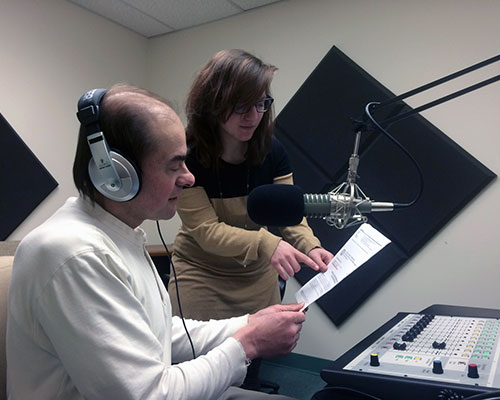News Director Dana Esmel and Northern Essex Community College intern Sarah Tiso prepare a local newscast.
Community engagement is ‘making a top priority to listen, to join & lead conversation to elevate our journalism.’
A Series Examining the Evolution of Local News
Part 5 of a 5-part series
This series examines the evolving and lasting role of local news reporting, effects of WHAV’s unique entrepreneurial approach in shaping a competitive market, intersection of cutting edge and traditional technologies, importance of looking back in order to move forward and a bold vision of the future that offers advantages for residents now.
By Tim Coco
President and General Manager
“Community engagement” is the latest buzzword in society at large—and particularly in newsrooms.
While others are bandying about this term, attending seminars and webinars and chatting in highbrow style about the possibilities of community engagement, some have been doing it all along and will continue to do so. They do the job not because its trendy, but because they are in business. To those who want to skip the next few paragraphs, suffice to say this is a new term for the commonsense “give and take” approach.
“I want to help more journalists build with their communities, not just for their communities,” wrote Josh Stearns in his 2015 article, “Building Journalism With Community, Not For It.” He goes on to try to explain community engagement by saying, “The distinction between ‘building with’ instead of ‘building for’ feels at first like semantics. However, when we begin to use it as a lens to examine journalism as both a process and a product, we see numerous small and large ways it challenges the status quo.”
Pretty clear, right? Um no. Let’s hear then from the National Federation of Community Broadcasters. Quoting the National Center for Media Engagement, it says community engagement is “Collaboratively discovering, understanding and addressing community needs and aspirations. Engagement: builds ongoing, two-way relationships; involves listening to people; means working with the community to mutually identify solutions; focuses on learning from the community.”
Now, we’re getting somewhere…sort of. Let’s try again. Steve Buttry, director of student media at Louisiana State University’s Manship School of Mass Communication, writing in 2011, said community engagement is “making a top priority to listen, to join & lead conversation to elevate our journalism.” This explanation didn’t sit well with the Washington Post’s Patrick B. Pexton. He boiled down the jargon and concluded theorists really mean reporters should be “using Twitter and Facebook to build a tribe or family of followers, even disciples, who will keep reading you.”
Action Instead of Talk
The entire debate makes one wonder how many news stories were missed while the relatively few reporters and editors left were talking about how not to miss news stories.
Commenting on this WHAV news series, a person identified only as “Resident,” complained, “I was excited about this series at first but this seems like a long winded, subjective advertisement for WHAV.” “Resident” is actually pretty close. In this series, non-profit WHAV’s goal was to explain what it does differently from others who seemingly can’t adapt to the modern world and why it needs your support—financial and otherwise.
The bottom line is WHAV is meeting public needs in entrepreneurial fashion, while others are mostly talking about doing the job. If Pexton’s interpretation of community engagement is correct, WHAV has gone even further—publishing not only to Twitter and Facebook, but also to LinkedIn, Google Plus, Tumblr and others. If the “give and take” definition holds, WHAV receives continuous feedback—mostly anonymously as many seem to prefer—from readers and listeners posting at WHAV.net and via social media. It also takes them from press releases, during its live Open Mike Show Monday nights, at public meetings, over the telephone and via old-fashioned letters. Civic and charitable groups may even voice their own “Community Spotlight” messages. Sounds like community engagement.
WHAV’s new FM station adds another method of interacting with the public. So far—if about five million web page views a month is any example—residents value WHAV’s service. It has filled a void in the marketplace. Going forward, WHAV offers a bold new vision. It intends to tell Haverhill’s story to national audiences by becoming a major contributor of programming for affiliates of the Pacifica Network and other distribution points. It also remains dedicated to proactive and professional newsgathering — more urgent than ever as traditional media continues to shrink and dissolve.
A word of caution though. WHAV won’t be able to continue doing the job without your continued donations and sponsorships.
Help WHAV “Make Waves” and Bring Local News to FM
 Tom Bergeron, honorary chairperson of WHAV’s “Make Waves” campaign, is asking for your help in raising at least $100,000 to put Haverhill’s own FM radio station on the air. A rare window of opportunity has opened that could put WHAV on FM sooner than anticipated, but it is dependent on your generosity. Please support the only Haverhill-based news source that’s always free with your donation by clicking here.
Tom Bergeron, honorary chairperson of WHAV’s “Make Waves” campaign, is asking for your help in raising at least $100,000 to put Haverhill’s own FM radio station on the air. A rare window of opportunity has opened that could put WHAV on FM sooner than anticipated, but it is dependent on your generosity. Please support the only Haverhill-based news source that’s always free with your donation by clicking here.

